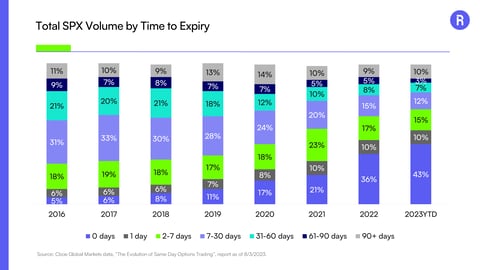Option Deep Dive - What is a Digital Option?
Vanilla versus Exotic Options
In prior blogs, we have covered the in-depth nature of options: Greek risk, forwards, leverage, et cetera. It’s worth noting that these blogs all referred to vanilla options. Vanilla options refer to standard puts and calls, which regularly trade in listed markets. What many retail investors may not know is that there is a whole realm of options outside of vanillas referred to as exotics.
In order to properly explain, some background context may be helpful. In my previous role before joining Roundhill, I sat on an equity derivatives structuring desk on Wall Street. Equity derivatives structuring involves modeling and pricing vanilla and exotic option packages in over-the-counter (OTC) format. That is the historical context in which exotic options have traded: between banks and their clients. They do not trade on listed exchanges, which has made most exotic options very inaccessible to retail investors.
Introducing Digis
One of the simplest forms of an exotic option is a digital option, which can also be referred to as a binary option. It is named a digital or a binary due to the nature of its payout being either 0 or 100%. A digital call option will pay out 100% of notional if the underlying asset trades above a certain strike or barrier at maturity. Conversely, a digital put will pay out 100% of notional if the underlying asset trades below a certain strike or barrier at maturity.
Digitals are frequently quoted by their payout multiple. For example, if a digital call costs 20% premium, it is quoted with a 5:1 payout (100% notional / 20% premium). The higher the multiple, the more attractive the payout is in relation to the premium cost.
Synthetically Creating a Digital Using Vanillas
The best way to understand exotic options is to synthetically create them using vanilla options. Nearly every exotic option can be replicated using vanillas, and that methodology is typically how banks will hedge their risk in listed markets after they buy or sell exotic products. In theory, a digital option is an infinitely leveraged call or put spread, where the long and short strikes are so close together that they are effectively the same strike. A long digital call is replicated using a call spread, and a long digital put using a put spread. Let’s proof it out.
We’ll start with a standard call spread, and we’ll chart its payout at expiry for simplicity’s sake. The below call spread has a 100% (at-the-money) long call strike and a 110% (10% out-of-the-money) short call strike with 1X leverage. The call spread’s maximum payout is the upper strike - lower strike * leverage. In this case (110% - 100%) * 1 or 10%.
For illustrative purposes only
As mentioned earlier, a digital has one strike and a call spread has two. In order to replicate a call spread into a digital, we’ll need to narrow the spread width as tightly as possible. Let’s begin by modifying halfway to a digital and cut the barrier width in half to 5%. We’ll use strikes of 102.5% by 107.5% and maintain the same 105% midpoint as our prior call spread. In order to preserve that same 10% coupon that we’re looking for, we’ll need to double the leverage to 2X. Recall the earlier maximum payout formula: (107.5% - 102.5%) * 2 = 10%.
Notice how the payout got much steeper? A true digital option has infinite leverage (meaning a straight line up instead of a slope), but this is getting closer.
For illustrative purposes only
Let’s modify it again. We’ll make the spread width just 1% between long and short strikes. This will require 10X leverage to attain a 10% payout at expiry if the underlying asset is trading above the short strike ( (105.5% - 104.5%) * 10 = 10% ). This option package is now quite similar to a digital call option with a 105% strike.
For illustrative purposes only
If we put all 3 charts together, you can see the progression of how a digital option can be replicated using vanilla call options.
For illustrative purposes only
Now that we’ve walked through the proof, the cost of a digital option should roughly make sense. It should be comparable to a similarly struck call/put spread, assuming leverage is utilized to mimic an identical payout amount. While the upfront premiums may differ (due to a digital seeking a 100% payout and a listed trade seeking a payout determined by the spread’s width), the payout multiple should be similar between a digital and its listed spread trade. For example, if the 100% x 110% call spread costs 5% (2:1 payout), the digital’s premium should be in the range of 50% (2:1 payout).
Real World Use Case
Imagine you are a client of Morgan Stanley and you call up your equity sales desk coverage and ask to trade a digital call on the S&P 500. Because this is an over-the-counter instrument, it can only be traded directly with a bank. Morgan Stanley wants to sell you that digital option, but, depending on how it performs, they will owe you its performance. The trading desk will need to hedge the risk associated with shorting that digital option.
In order to account for their risk, Morgan Stanley will price the digital option assuming certain buffers or barrier levels, roughly around the call strikes that can reasonably hedge using listed call spreads. That price will then be communicated to you (the client). If you choose to trade, you’ll own a digital call, and Morgan Stanley will be short a digital call, long many listed call spreads, and ideally risk neutral. This is an overly simplified version of the events that would take place in trading a digital call, but it gives retail investors a glimpse into how exotic options are traded and risk-managed.
Why Would I Want This?
Now that we’ve stated how similarly digitals and spreads behave and price, why would someone ever trade an OTC digital option when they can instead trade the vanilla spread? The answer to that question usually lies in leverage. Digitals incorporate an infinite amount of leverage around one particular level (or strike) of the underlying asset. That leverage allows digitals to massively outperform the underlying asset when they expire in-the-money. This isn’t to say that digital options come without downside. They are traditionally expensive, and if they expire out of the money, the buyer loses all premium paid.
Digitals, as well as all other exotic options, require a comprehensive understanding of options before trading, but they can be strategically used to gain exposure to leverage unavailable in listed markets.
Interested in learning more? Check out the rest of our Options Deep Dives.
- Options Deep Dive: “This stock is going to the moon” … Then why are you writing calls?
- Options Deep Dive: 3 Rounds in the Ring - XPAY vs XDTE
- Option Greeks Deep Dive - Theta: What Am I Paying For?
Not an offer: This document does not constitute advice or a recommendation or offer to sell or a solicitation to deal in any security or financial product. It is provided for information purposes only and on the understanding that the recipient has sufficient knowledge and experience to be able to understand and make their own evaluation of the proposals and services described herein, any risks associated therewith and any related legal, tax, accounting or other material considerations. To the extent that the reader has any questions regarding the applicability of any specific issue discussed above to their specific portfolio or situation, prospective investors are encouraged to contact 1-855-561-5728 or consult with the professional advisor of their choosing.
Forward-looking statements: Certain information contained herein constitutes “forward-looking statements,” which can be identified by the use of forward-looking terminology such as “may,” “will,” “should,” “expect,” “anticipate,” “project,” “estimate,” “intend,” “continue,” or “believe,” or the negatives thereof or other variations thereon or comparable terminology. Due to various risks and uncertainties, actual events, results or actual performance may differ materially from those reflected or contemplated in such forward-looking statements. Nothing contained herein
Use of Third-party Information: Certain information contained herein has been obtained from third party sources and such information has not been independently verified by Roundhill Financial Inc. No representation, warranty, or undertaking, expressed or implied, is given to the accuracy or completeness of such information by Roundhill Financial Inc. or any other person. While such sources are believed to be reliable, Roundhill Financial Inc. does not assume any responsibility for the accuracy or completeness of such information. Roundhill Financial Inc. does not undertake any obligation to update the information contained herein as of any future date.



